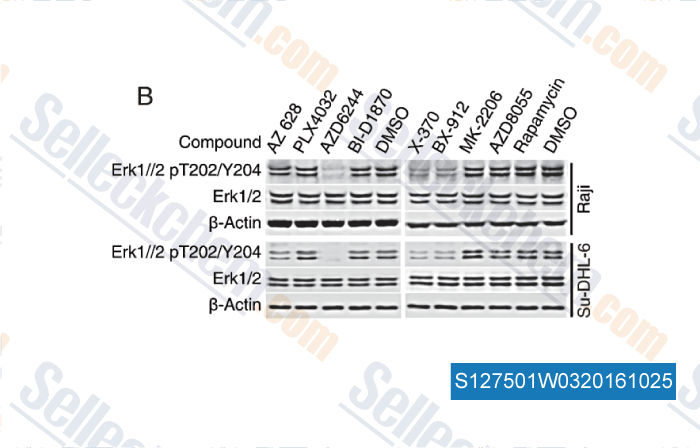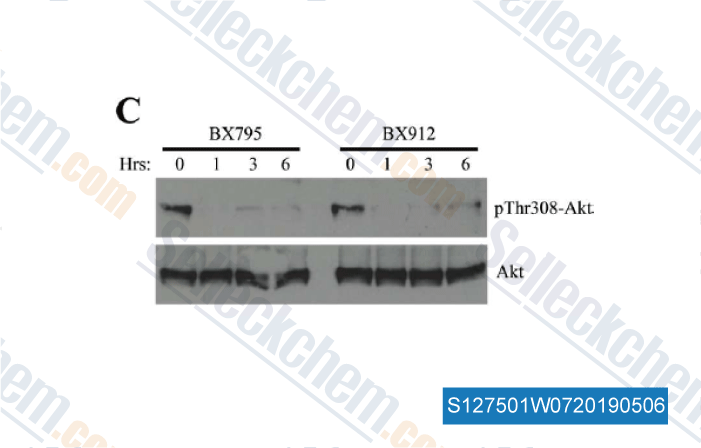|
Toll Free: (877) 796-6397 -- USA and Canada only -- |
Fax: +1-832-582-8590 Orders: +1-832-582-8158 |
Tech Support: +1-832-582-8158 Ext:3 Please provide your Order Number in the email. |
Technical Data
| Formula | C20H23BrN8O |
||||||||||
| Molecular Weight | 471.35 | CAS No. | 702674-56-4 | ||||||||
| Solubility (25°C)* | In vitro | DMSO | 94 mg/mL (199.42 mM) | ||||||||
| Ethanol | 94 mg/mL (199.42 mM) | ||||||||||
| Water | Insoluble | ||||||||||
| In vivo (Add solvents to the product individually and in order) |
|
||||||||||
|
* <1 mg/ml means slightly soluble or insoluble. * Please note that Selleck tests the solubility of all compounds in-house, and the actual solubility may differ slightly from published values. This is normal and is due to slight batch-to-batch variations. * Room temperature shipping (Stability testing shows this product can be shipped without any cooling measures.) |
|||||||||||
Preparing Stock Solutions
Biological Activity
| Description | BX912 is a potent and specific PDK1 inhibitor with IC50 of 12 nM, 9- and 105- fold greater selectivity for PDK1 than PKA and PKC in cell-free assays, respectively. In comparison to GSK3β, selectivity for PDK1 is 600-fold. | |||||||||||
|---|---|---|---|---|---|---|---|---|---|---|---|---|
| Targets |
|
|||||||||||
| In vitro | BX912 prevents ChcK1, PKA, c-kit, and KDR with IC50 of 0.83, 0.11, 0.85, and 0.41 μM, resepectively. BX912 blocks PDK1/Akt signaling in tumor cells and suppresses the anchorage-dependent growth of a variety of tumor cell lines (such as PC-3 cells ) in culture or induces apoptosis. A number of cancer cell lines (such as MDA-468 breast cancer) with elevated Akt activity are >30-fold more sensitive to growth inhibition by PDK1 inhibitor BX912 in soft agar than on tissue culture plastic, consistent with the cell survival function of the PDK1/Akt signaling pathway, which is particularly important for unattached cells. BX912 potently blocks PDK1 enzyme activity in a direct kinase assay format, although BX912 fails to block preactivated AKT2 activity (IC50 > 10 μM). Therefore, BX-912 is a direct inhibitor of PDK1. BX912 is a competitive inhibitor of PDK1 activity with respect to its substrate, ATP, suggesting that BX912 binds to the ATP binding pocket of PDK1. The aminopyrimidine backbone of BX912 adopts a similar orientation in the active site of PDK1. BX912 promotes a pronounced increase in the population of MDA-468 cells with 4 N DNA content, indicative of a block at the G2/M phase of the cell cycle. BX912 also potently inhibits the growth of HCT-116 cells in soft agar, showing a 96% inhibitory effect at a dose of 1 μM. BX912 potently inhibits the growth of PC-3 cells in soft agar, displaying IC50 of 0.32 μM. [1] |
Protocol (from reference)
| Kinase Assay:[1] |
|
|---|---|
| Cell Assay:[1] |
|
References
|
Customer Product Validation

-
, , Oncotarget, 2014, 5(21):10732-44.

-
Data from [ , , Am J Respir Cell Mol Biol, 2018, 59(3):295-305 ]
Selleck's BX-912 Has Been Cited by 14 Publications
| Deregulation and epigenetic modification of BCL2-family genes cause resistance to venetoclax in hematologic malignancies [ Blood, 2022, blood.2021014304] | PubMed: 35704690 |
| The 3-phosphoinositide-dependent protein kinase 1 is an essential upstream activator of protein kinase A in malaria parasites [ PLoS Biol, 2021, 19(12):e3001483] | PubMed: 34879056 |
| Effects of inhibiting PDK‑1 expression in bone marrow mesenchymal stem cells on osteoblast differentiation in vitro [ Mol Med Rep, 2021, 23(2)118] | PubMed: 33300048 |
| Application of a Biphasic Mathematical Model of Cancer Cell Drug Response for Formulating Potent and Synergistic Targeted Drug Combinations to Triple Negative Breast Cancer Cells. [ Cancers (Basel), 2020, 27;12(5)pii: E1087] | PubMed: 32349331 |
| Biphasic Mathematical Model of Cell-Drug Interaction That Separates Target-Specific and Off-Target Inhibition and Suggests Potent Targeted Drug Combinations for Multi-Driver Colorectal Cancer Cells. [ Cancers (Basel), 2020, 13;12(2) pii: E436] | PubMed: 32069833 |
| Gene Essentiality Profiling Reveals Gene Networks and Synthetic Lethal Interactions with Oncogenic Ras. [ Cell, 2019, 36(2):179-193] | PubMed: 28162770 |
| A Pharmacogenomic Landscape in Human Liver Cancers. [ Cancer Cell, 2019, 36(2):179-193] | PubMed: 31378681 |
| Mapping phospho-catalytic dependencies of therapy-resistant tumours reveals actionable vulnerabilities. [ Nat Cell Biol, 2019, 21(6):778-790] | PubMed: 31160710 |
| Discoidin Domain Receptor 2 Signaling Regulates Fibroblast Apoptosis through PDK1/Akt [Jia S Am J Respir Cell Mol Biol, 2018, 59(3):295-305] | PubMed: 29652518 |
| Systematic Functional Characterization of Resistance to PI3K Inhibition in Breast Cancer. [ Cancer Discov, 2016, 6(10):1134-1147] | PubMed: 27604488 |
RETURN POLICY
Selleck Chemical’s Unconditional Return Policy ensures a smooth online shopping experience for our customers. If you are in any way unsatisfied with your purchase, you may return any item(s) within 7 days of receiving it. In the event of product quality issues, either protocol related or product related problems, you may return any item(s) within 365 days from the original purchase date. Please follow the instructions below when returning products.
SHIPPING AND STORAGE
Selleck products are transported at room temperature. If you receive the product at room temperature, please rest assured, the Selleck Quality Inspection Department has conducted experiments to verify that the normal temperature placement of one month will not affect the biological activity of powder products. After collecting, please store the product according to the requirements described in the datasheet. Most Selleck products are stable under the recommended conditions.
NOT FOR HUMAN, VETERINARY DIAGNOSTIC OR THERAPEUTIC USE.
